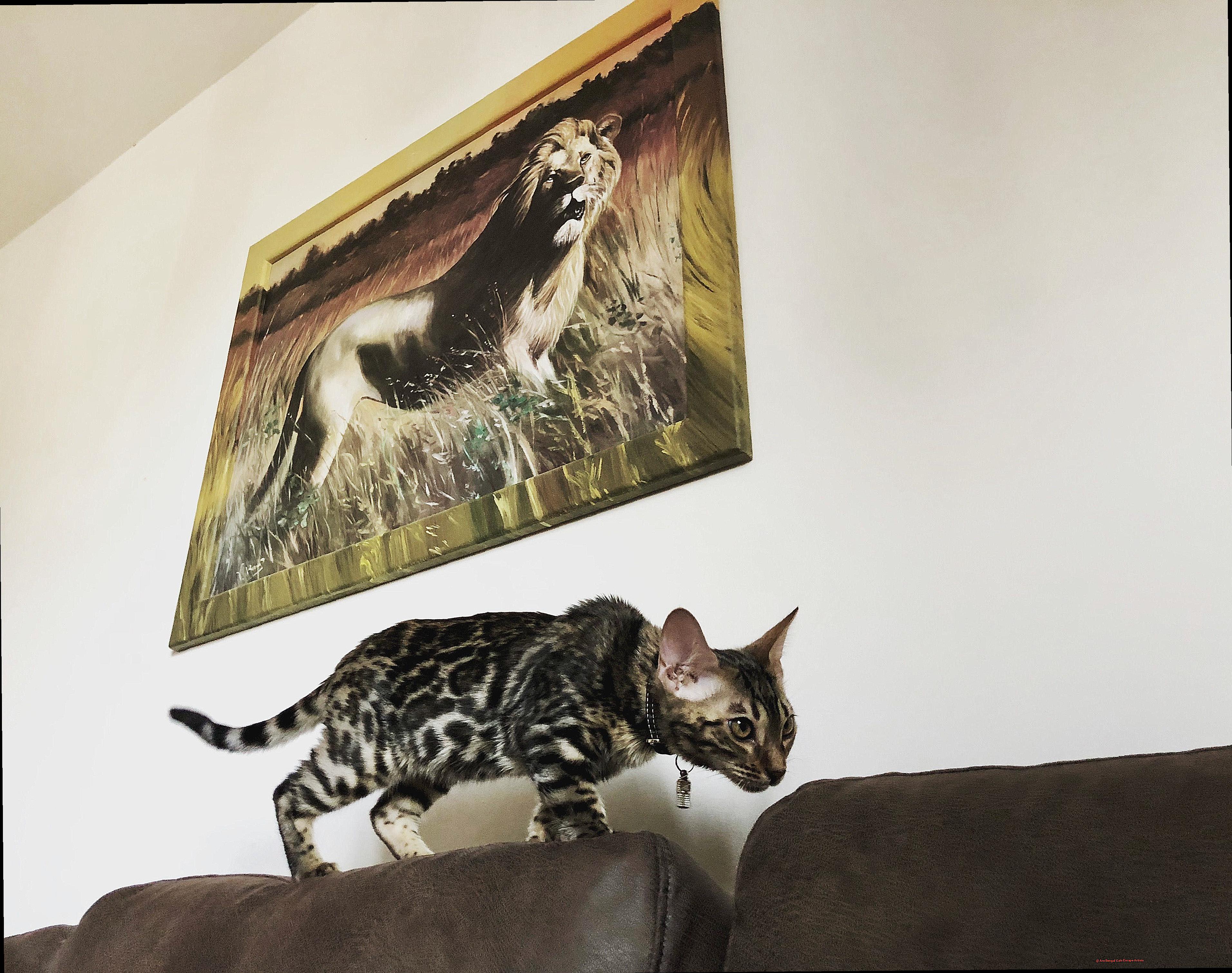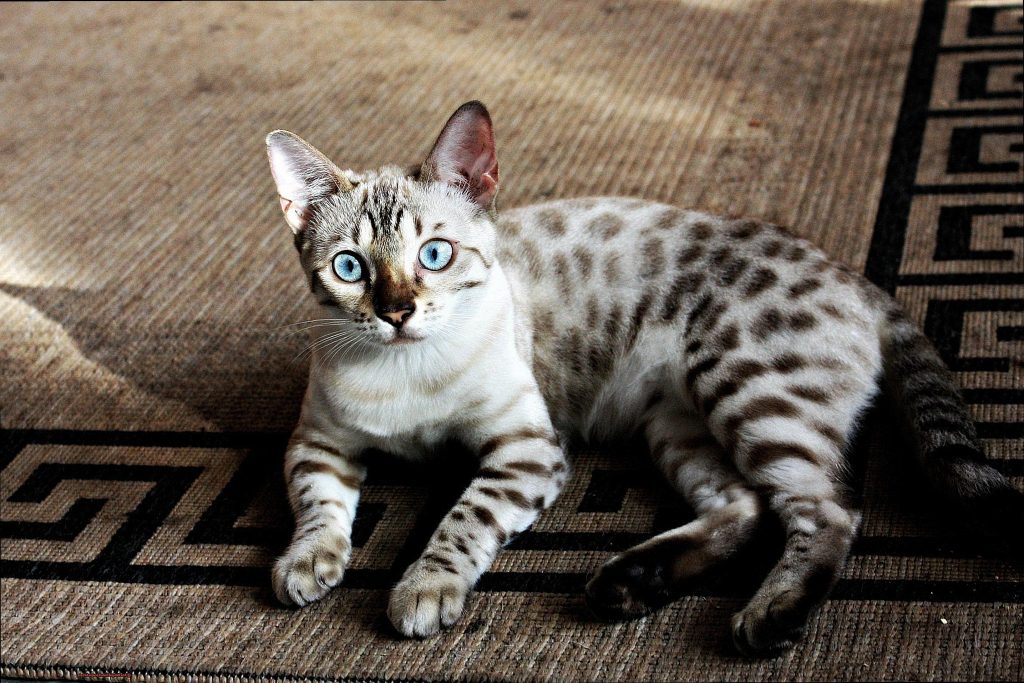Bengal cats are more than just a pretty face – they also possess a cunning and adventurous spirit that often leads them to escape from even the most secure environments.
As a fellow Bengal cat owner, I’ve experienced firsthand their incredible Houdini-like abilities and can attest to their knack for finding ways to explore beyond the confines of our homes. In this blog post, we’ll take a closer look at why these wild-looking felines are such skilled escape artists and share some tips on how to keep your mischievous kitty from pulling disappearing acts.
So hold onto your hats (and your cats), because we’re about to uncover the escapades of Bengal cats.
Are Bengal Cats Escape Artists?
Contents
Bengal cats are a unique and exotic breed, known for their striking appearance and wild ancestry. But there’s one trait that sets them apart from other domesticated cats – their incredible ability to escape. If you’re a Bengal cat owner, you may have experienced this first-hand, or perhaps you’ve heard stories from other owners about their Houdini-like felines. In this blog post, we’ll dive into the world of Bengal cats and their escape artist tendencies, providing valuable insights and tips for keeping your curious and clever cat safe and secure.
Why Are Bengal Cats Escape Artists?
To understand why Bengal cats are notorious for escaping, it’s essential to know a bit about their history and genetic makeup. These beautiful felines are a hybrid breed, created by crossing domestic cats with wild Asian Leopard cats. This means that they still possess many traits and behaviors of their wild ancestors, including a strong instinct to explore and roam. This natural drive can lead them to try to escape from their homes or enclosures in search of adventure.
In addition to their wild ancestry, Bengal cats are also known for being active, energetic, and highly intelligent. These traits make them more likely to find ways to escape, whether it’s through open windows, doors, or even small gaps in fences or enclosures.
Their high prey drive can also contribute to their escape artist tendencies, as they may try to chase after birds or other small animals that catch their attention.
Common Methods of Escape
Bengal cats are resourceful creatures and will use any means necessary to escape. Some common methods they may employ include jumping over fences or barriers, climbing up onto high surfaces like shelves or countertops, or squeezing through small openings. They may also manipulate locks or doors if they are particularly crafty and determined.
Creating a Secure Environment
Prevention is key when it comes to keeping Bengal cats from escaping. As an owner, it’s crucial to thoroughly inspect your home and outdoor enclosures for any potential escape routes.
Make sure all doors and windows are securely closed and locked, and consider installing childproof locks on doors that your cat can reach. For outdoor enclosures, use sturdy fencing with no gaps or holes, and secure any potential escape routes, such as tree branches or nearby structures.
The Wild Ancestry of Bengal Cats and its Impact on their Behavior
Bengal cats are known for their striking appearance and playful personalities, but their wild ancestry sets them apart from other domestic cat breeds. As descendants of the Asian leopard cat, Bengals inherit a set of skills and instincts that make them exceptional escape artists. In this section, we will explore the influence of their wild ancestry on their behavior and how it can help prevent escapes.
The Asian leopard cat is a small wildcat found in parts of Asia, including India, China, and Indonesia. These agile and athletic cats have evolved to survive in the wild, making them skilled escape artists. This ability has been passed down to Bengal cats, making them notorious for finding ways to break free from their homes.
One of the physical characteristics inherited from the Asian leopard cat that aids in escaping is their muscular and lean body. These cats are built for speed and agility, allowing them to quickly climb, jump, and maneuver through small spaces. This makes it easier for Bengal cats to find and exploit potential escape routes.
In addition to their physical capabilities, Bengal cats also have instinctual behaviors developed for survival in the wild. This includes a strong prey drive, which can lead them to try and escape in search of potential prey. This is why it’s important to keep your Bengal cat entertained with toys and activities to satisfy their natural hunting instincts.
Bengals also have a high level of intelligence and curiosity, inherited from their wild ancestors. This combination can make them determined and persistent when trying to escape. They will test boundaries and find ways to open doors or windows to explore the world outside.
To prevent escapes, it’s important for Bengal cat owners to create a secure environment for their feline friend. This includes keeping doors and windows closed and ensuring there are no small spaces they can squeeze through. Providing plenty of mental and physical stimulation through interactive toys and playtime can also help satisfy their curious nature.
The Curiosity and Independence of Bengal Cats: Why They May Try to Escape
Bengal cats are not your typical lap cats – they have a wild side that sets them apart from other domestic breeds. As an owner of one of these beautiful and intelligent creatures, you may have experienced their relentless attempts to break free from their homes. But have you ever wondered why your Bengal cat is always trying to escape?
In this blog post, we’ll explore the reasons behind this behavior and provide tips on how to address it.
Their Wild Ancestry
The first thing to understand is that Bengal cats are descendants of the Asian leopard cat, a small wild cat native to Asia. This wild ancestry has left a lasting impact on their behavior, making them more curious and adventurous than your average house cat.
These cats have a strong instinct for exploration and hunting, which can lead them to constantly try to escape from their homes in search of new experiences.
High Energy Levels
Bengal cats are also known for their high energy levels. This is partly due to their wild ancestry, as they were originally bred for their agility and athleticism. These cats need plenty of physical activity to stay happy and healthy, and if they don’t get enough, they may turn to escaping as a way to release pent-up energy. Providing your Bengal cat with interactive toys and designated play areas can help fulfill their need for physical stimulation and prevent escape attempts.
Intelligence and Boredom
In addition to their physical needs, Bengal cats are also highly intelligent creatures. This means they need mental stimulation as well. Without enough mental stimulation, these clever cats can become bored easily and seek out new experiences outside of their homes. It’s important for owners to provide their Bengal cats with toys and activities that challenge their minds and keep them entertained.
Feeling Confined
Bengal cats are also highly independent animals and may become frustrated if they feel confined or restricted in their environment. This can lead to attempts to escape as a way to gain more freedom. It’s important for owners to provide their Bengal cats with enough space and opportunities to explore and play, while also setting boundaries and providing proper training to prevent escapes.
How High Prey Drive Contributes to Bengal Cats’ Escape Artist Tendencies
Bengal cats are known for their stunning looks and wild-like appearance. But behind those mesmerizing eyes and beautiful coat lies a strong instinct that can cause headaches for their owners – their high prey drive.
As natural hunters, Bengal cats have an insatiable urge to chase and capture prey. This instinct is deeply ingrained in their DNA, making it difficult to control or suppress. It also contributes to their escape artist tendencies, as they are constantly on the lookout for potential prey or new environments to explore.
So, how can you prevent your Bengal cat from becoming an escape artist? Here are some research-backed tips:
Secure Their Living Space
One of the best ways to prevent your Bengal cat from escaping is by ensuring that their living space is secure and escape-proof. This includes using sturdy fences or netting on outdoor enclosures to prevent them from climbing or jumping out.
Supervise Outdoor Time
If your Bengal cat loves spending time outdoors, it is important to supervise them at all times. This not only helps keep them safe but also prevents them from escaping and potentially getting lost.
Provide Mental Stimulation
Bengal cats are intelligent and highly energetic, so it is important to provide them with plenty of mental stimulation and playtime. This helps satisfy their high prey drive and keeps them content at home.
Redirect Their Hunting Instincts
Instead of trying to suppress your Bengal cat’s hunting instincts, redirect them by providing interactive toys or puzzles that mimic the thrill of hunting and chasing prey. This will not only keep them entertained but also prevent them from seeking out real prey.
Keep Them Indoors
While some owners may prefer to let their cats roam freely outdoors, it is recommended to keep Bengal cats indoors for their safety. Not only does this prevent them from escaping, but it also keeps them safe from potential predators and other dangers.
Intelligence and Problem-Solving Abilities: Factors that Make Bengal Cats More Likely to Escape
Bengal cats are not your average house cat. These stunning creatures possess a unique set of traits that make them stand out from the rest. From their exotic appearance to their high energy levels, there’s no denying that Bengal cats are a breed like no other. But one trait that can often cause concern for owners is their tendency to escape.
So, why do these felines have such a knack for breaking free? Let’s explore the factors that make Bengal cats more likely to escape.
High intelligence and problem-solving abilities
Bengal cats are the result of breeding domestic cats with Asian leopard cats, known for their intelligence and agility. This genetic makeup gives Bengal cats a high level of intelligence and problem-solving abilities, making them more likely to figure out how to unlock doors, climb fences, and find hidden weak spots in enclosures.
Natural curiosity
Bengal cats are naturally curious creatures and love to explore their surroundings. They have an insatiable desire for new and interesting things, which can lead them to venture outside of their designated areas in search of adventure. This curiosity is a natural part of their behavior and can be challenging for owners to manage.
High activity levels
Bengal cats are known for their high energy levels and require plenty of mental and physical stimulation to keep them happy and healthy. If they do not receive enough stimulation, they can become bored and seek out ways to escape in search of new adventures. It’s important for owners to provide adequate outlets for their cat’s energy, such as toys, puzzles, and interactive playtime.
Desire for independence
Bengal cats may also have a strong desire for independence, which can contribute to their escape tendencies. These felines are not content with being confined in a home or enclosure and may try to break free to explore on their own terms. This desire for independence is a natural part of their personality and should be respected by owners.
So, what can Bengal cat owners do to prevent their feline friends from escaping? The key is understanding these factors and taking necessary precautions. This could include securing their living space, supervising outdoor time, providing adequate stimulation, redirecting their hunting instincts, and keeping them indoors for safety.
Preventing Escapes: Tips for Keeping Your Bengal Cat Safe at Home

Bengal cats are a unique and exotic breed, known for their beautiful markings and adventurous personalities. But along with their high energy and curiosity, many Bengal cat owners also face the challenge of preventing escapes. If you’re worried about your Bengal cat’s tendency to try and escape, we’re here to help.
In this blog post, we’ll share expert tips and personal experiences on creating a safe and secure environment for your Bengal cat and ensuring their safety at home.
Understanding the Escape Artist Tendencies of Bengal Cats
Bengal cats are descendants of wild Asian Leopard cats, which gives them a natural drive to explore and roam. This can make them more likely to try and escape from their homes or enclosures compared to other domestic cat breeds. Along with their wild ancestry, their intelligence, high energy, and prey drive also contribute to their escape artist tendencies. By understanding these factors, we can better prepare ourselves in preventing escapes.
Creating an Escape-Proof Environment
The first step in preventing escapes for Bengal cats is to ensure that your home is escape-proof. This means checking for any openings or gaps in fences or windows that your cat could potentially squeeze through. Investing in sturdy screens and latches for doors and windows is crucial in keeping your cat from escaping. Additionally, outdoor enclosures should be tall and secure, as Bengal cats are excellent climbers and jumpers.
Keeping Your Bengal Cat Mentally Stimulated
Boredom can often lead to cats trying to escape in search of adventure. To prevent this, it’s essential to keep your Bengal cat mentally stimulated. Providing plenty of toys, puzzles, and interactive playtime can help satisfy their natural curiosity and energy levels. You can also create a safe and comfortable indoor environment for your cat, with scratching posts, perches, and hiding spots to keep them entertained.
Training and Socialization for Bengal Cats
Proper training and socialization can also play a significant role in preventing escapes. Teaching your Bengal cat basic commands like “come” or “stay” can be useful in case of any potential escape attempts. Positive reinforcement is key in training these intelligent cats. Ensuring that they are well-socialized and have a regular routine can also help reduce their desire to escape.
Microchipping as a Safety Precaution
Even with all the necessary precautions, accidents can still happen, and your Bengal cat may find a way to escape. In these situations, it’s crucial to have a backup plan. Microchipping your cat is highly recommended as it greatly increases the chances of being reunited with them if they do escape.
Training and Socialization: Techniques for Reducing Escape Artist Behaviors in Bengal Cats
Bengal cats are known for their stunning appearance and wild-looking markings, but they also have a reputation for being escape artists. These intelligent and active cats have a strong desire to explore and can easily find their way out of homes or yards if their needs are not met.
As a Bengal cat behavior expert, I have seen first-hand the importance of training and socialization in preventing escape artist behaviors. In this section, I will share effective techniques to help you keep your Bengal cat safe at home.
Start Training and Socialization Early
The key to preventing escape artist behaviors in Bengal cats is to start training and socialization at an early age. When you bring your Bengal kitten home, begin teaching them basic commands like “come” and “stay” using positive reinforcement techniques such as clicker training and treats. This will help them understand that staying close to you is rewarding and desirable behavior.
Socialization is also crucial in helping Bengal cats feel comfortable and confident in their surroundings. Introduce them to new people, places, and experiences slowly and positively. This will help them become more familiar with their environment and reduce the likelihood of escape attempts.
Provide Mental Stimulation
Bengal cats are highly intelligent and need mental stimulation to prevent boredom, which can lead to escape attempts. Make sure to provide plenty of toys, scratching posts, and interactive games for your Bengal cat to play with. Regular playtime and rotation of toys will help keep them mentally stimulated.
You can also create an enriching environment for your Bengal cat by setting up perches near windows, installing shelves for climbing, or creating hiding spots with boxes or tunnels. This will satisfy their natural desire to climb and explore without feeling the need to escape.
Secure Your Living Space
Even with proper training and socialization, it is important to provide a secure living space for your Bengal cat. Make sure all doors and windows are properly secured, and consider installing screens or locks to prevent any escape attempts. Outdoor enclosures or cat runs can also be a great option for Bengal cats to safely enjoy the outdoors.
Conclusion
In conclusion, Bengal cats are not your average house cat – they possess a fierce and adventurous spirit that often leads them to escape from even the most secure environments. As fellow Bengal cat owners, we have experienced firsthand the challenges of keeping these cunning felines from pulling disappearing acts.
With their wild ancestry, high intelligence, and insatiable curiosity, it’s no surprise that they have such a knack for escaping.
By understanding the factors that contribute to their escape artist tendencies and implementing some simple tips and techniques, you can create a safe and secure environment for your Bengal cat. From fortifying your living space with escape-proof measures to providing mental stimulation through interactive toys and proper training and socialization, there are many ways to prevent escapes.
Remember to start training and socialization early on in your Bengal cat’s life, provide plenty of mental enrichment activities, and always keep a watchful eye when they are outdoors. And in case of any accidental escapes, microchipping is an excellent safety precaution to ensure your feline friend can be easily identified if found.
So, embrace your Bengal cat’s wild side but also take the necessary precautions to keep them safe at home. After all, as the saying goes – “curiosity killed the cat,” but with proper care and attention, we can ensure our beloved Bengals satisfy their curiosity without putting themselves in harm’s way.






